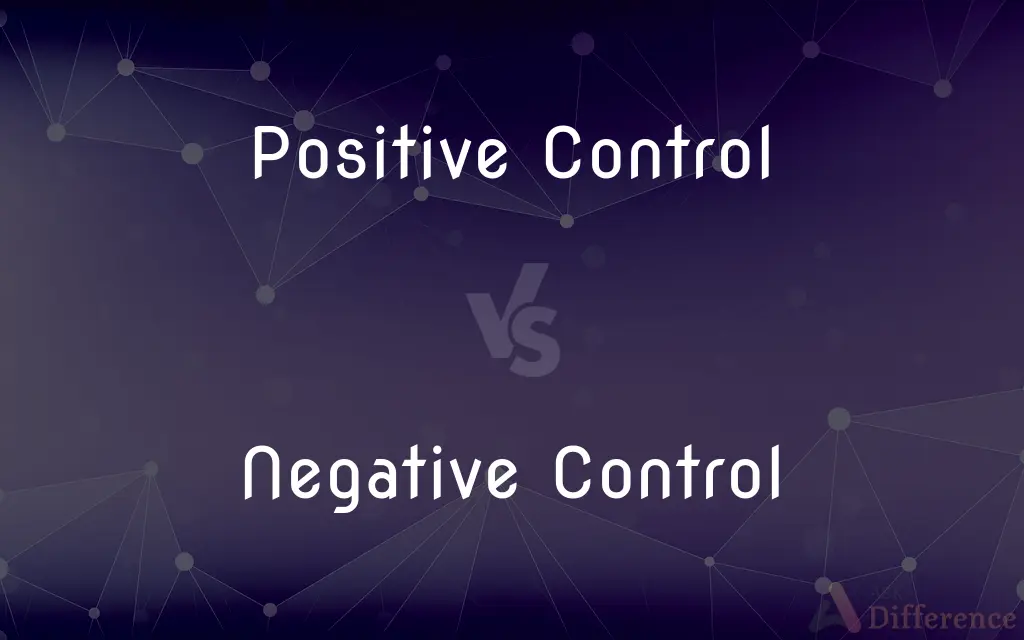Positive Control vs. Negative Control — What's the Difference?
Edited by Tayyaba Rehman — By Fiza Rafique — Published on December 20, 2023
Positive Control ensures a known response to confirm test validity, while Negative Control ensures no response under ideal conditions. Both aid in validating experimental results.

Difference Between Positive Control and Negative Control
Table of Contents
ADVERTISEMENT
Key Differences
Positive Control is a crucial component in experiments, especially in biological and chemical studies. It is designed to demonstrate a known response, confirming that the testing procedure is functioning correctly. In essence, the Positive Control is the gold standard, ensuring that if the procedure works, it will produce a predictable outcome. It's akin to checking if a flashlight works by pressing the button and expecting light.
Conversely, Negative Control is designed to produce no response under ideal conditions. It helps to confirm that an experiment's results are due to the variable being tested and not due to other external factors. When working with Negative Control, scientists are ensuring that their setup is free from unwanted interferences. For example, if water is used as a Negative Control in an experiment testing a chemical reaction, the water shouldn't cause any reaction.
In many experiments, both Positive Control and Negative Control are essential for validating results. While Positive Control establishes that an experimental setup can produce a positive outcome when it should, Negative Control guarantees that the setup won't produce a false positive when it shouldn't. Together, these controls form the benchmarks that experimental results are compared against.
It's important to emphasize that neither Positive Control nor Negative Control provides the main experimental data. Instead, they offer context and confidence. While Positive Control confirms the experiment's sensitivity, Negative Control attests to its specificity, making them invaluable in scientific research.
Comparison Chart
Purpose
Validates test sensitivity
Validates test specificity
ADVERTISEMENT
Expected Result
Known response
No response
Use in Experiments
Shows test can detect positive result
Shows test won't produce false positives
Validation
Confirms functionality of procedure
Confirms no external interference
Example
A working flashlight producing light
Water causing no chemical reaction
Compare with Definitions
Positive Control
Benchmark for ensuring expected positive results.
In drug testing, a substance known to trigger a response acts as the Positive Control.
Negative Control
A test component expecting no outcome.
In a reaction, distilled water that doesn't cause a reaction is the Negative Control.
Positive Control
Experimental standard guaranteeing test sensitivity.
In a pregnancy test, a known positive sample is the Positive Control.
Negative Control
Benchmark ensuring no false positives in experiments.
In DNA amplification, a sample without target DNA is the Negative Control.
Positive Control
Validation tool in experiments confirming procedure accuracy.
A bacteria culture known to grow under given conditions is a Positive Control.
Negative Control
Assurance of test specificity.
In an allergy test, a substance known to be non-reactive for the patient is the Negative Control.
Positive Control
A test component expecting a known outcome.
In an enzyme activity assay, a known active enzyme serves as the Positive Control.
Negative Control
Validation tool showing experiments are interference-free.
In a bacteria culture, a sterile medium without nutrients acts as the Negative Control.
Positive Control
Assurance that an experiment can detect positive outcomes.
In an allergy test, a substance the patient is known to react to is used as a Positive Control.
Negative Control
A standard that should not elicit a response.
In drug tests, a substance known not to trigger the test is the Negative Control.
Common Curiosities
How does Negative Control differ?
Negative Control is designed to produce no outcome, ensuring the test won't produce false positives.
What is a Positive Control?
A Positive Control is used in experiments to ensure a predictable outcome, confirming test validity.
Can I run an experiment without a Positive Control?
While possible, without a Positive Control, you might lack confidence in the test's sensitivity.
What's the main use of a Negative Control?
Negative Control ensures results are due to the tested variable and not external factors.
Why are Positive Controls critical in research?
They provide assurance that an experiment can produce a positive outcome when expected.
Are Positive Controls always positive?
Yes, Positive Controls are expected to produce a known positive outcome.
Can a Negative Control be considered a "blank"?
Yes, in many cases, a Negative Control serves as a blank, showing no expected response.
How do Positive Control and Negative Control work together?
They provide benchmarks for experimental results, ensuring both sensitivity and specificity.
Do Negative Controls ever show a response?
Ideally, no. If they do, it might indicate experimental interference.
Share Your Discovery

Previous Comparison
Single-entry in Bookkeeping vs. Double-entry in Bookkeeping
Next Comparison
Behaviorism Psychology vs. Cognitive PsychologyAuthor Spotlight
Written by
Fiza RafiqueFiza Rafique is a skilled content writer at AskDifference.com, where she meticulously refines and enhances written pieces. Drawing from her vast editorial expertise, Fiza ensures clarity, accuracy, and precision in every article. Passionate about language, she continually seeks to elevate the quality of content for readers worldwide.
Edited by
Tayyaba RehmanTayyaba Rehman is a distinguished writer, currently serving as a primary contributor to askdifference.com. As a researcher in semantics and etymology, Tayyaba's passion for the complexity of languages and their distinctions has found a perfect home on the platform. Tayyaba delves into the intricacies of language, distinguishing between commonly confused words and phrases, thereby providing clarity for readers worldwide.












































